Saudi << SAW dee, sah OO dee, or SOW dee >> Arabia is a large Middle Eastern nation that ranks as one of the world’s leading producers of petroleum. Much of the country consists of vast deserts where few people live and little or nothing grows. But beneath the sand and rock and the offshore waters of Saudi Arabia lie some of the largest petroleum deposits in the world.
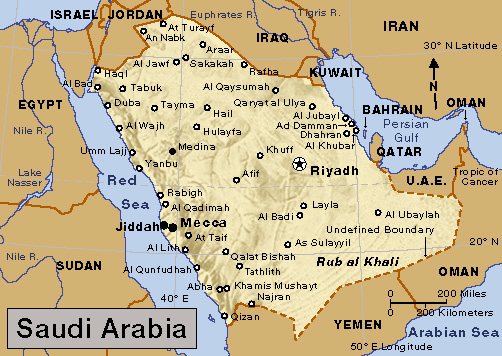
Saudi Arabia exports more oil than any other nation. Wealth from these exports has made Saudi Arabia a leading economic power in the Middle East. Automobiles and trucks speed along highways where camel caravans once provided the only transportation. High-rise office buildings and large homes of concrete, steel, and marble have replaced nearly all the mud houses that once lined city streets.
Saudi Arabia includes about three-fourths of the land region called the Arabian Peninsula. The country is bordered by Jordan, Iraq, and Kuwait to the north; the Persian Gulf (which Saudis call the Arabian Gulf) and the United Arab Emirates to the east; Oman and Yemen to the south; and the Red Sea to the west. Riyadh is Saudi Arabia’s capital and largest city.
The landscape of Saudi Arabia is mainly barren. Coastal plains and rugged mountains cover the western part of the country. Most of Saudi Arabia’s central area is a high plateau that has some oases where crops are grown. Deserts hem in the plateau to the north, south, and east. Within the eastern desert and along the Gulf coast lie most of Saudi Arabia’s rich oil fields.
Before the development of Saudi Arabia’s oil industry in the mid-1900’s, most of the people lived in rural areas and made a living as farmers, herders, or traders. With the growth of the oil industry, large numbers of people moved to cities and towns. Today, most Saudis live in urban areas, where they work in a variety of jobs. Many are employed by the government, the oil industry, and a growing number of other businesses and industries.
All people who hold Saudi citizenship are Muslims—that is, followers of the faith of Islam. Saudi Arabia holds a place of honor for all Muslims because the two holy cities of Islam—Mecca and Medina—are there. Mecca is the birthplace of the Prophet Muhammad, whose life and teachings form the basis of Islam. Medina is the city where Muhammad established the first Islamic community. Every year, millions of Muslim pilgrims from all over the world visit these cities. 
For hundreds of years, the land that is now Saudi Arabia was divided among a number of groups. By the beginning of the 1900’s, the eastern and western regions were under the loose control of the Ottoman Empire. The central region was ruled by local families. The country was unified during the early 1900’s as the result of conquests by Abd al-Azīz ibn Saud. In 1932, Ibn Saud proclaimed this territory the Kingdom of Saudi Arabia. Saudi Arabia remained a poor nation until the mid-1900’s, when income from the oil industry enabled it to begin modernization programs.
Government
National government
of Saudi Arabia is a monarchy under the Al Saud ruling family. The king holds executive and legislative powers. As leader of the nation’s spiritual affairs, he also holds the title Custodian of the Two Holy Mosques. This title refers to the Great Mosque in Mecca and the Prophet’s Mosque in Medina. The king is assisted in running the day-to-day affairs of the government by the Council of Ministers. The king heads the council and typically serves as prime minister. He has the power to appoint and dismiss the members of the council and to overrule all its decisions.
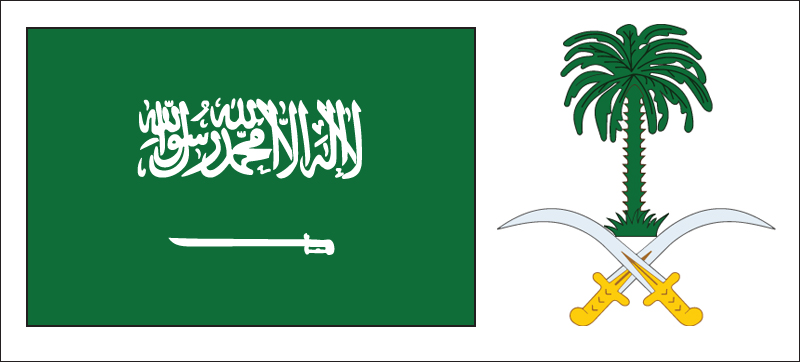
Saudi Arabia also has a Consultative Council that consists of a chairman and 150 other members, who are all appointed by the king. The council advises the monarch and can propose legislation. The monarch makes final decisions on all changes to Saudi law.
Saudi Arabia has no written constitution. But the Basic Law of Government, issued in 1992, declares the constitution of Saudi Arabia to be the Qur’ān, the Muslim holy book, and the Sunnah—that is, the example of the words and practices of Muhammad. The Qur’ān and Sunnah make up the Sharī`a (also spelled Sharī`ah), the body of Islamic law. Religious scholars known as the ulama are responsible for interpreting the Sharī`a and ensuring that Saudi laws follow it.
Local government.
Saudi Arabia is divided into 13 provinces. The king appoints the governors of the provinces. Each province has a council made up of certain government officials and a number of other members appointed by the king.
Courts.
Saudi laws are largely unwritten. Court rulings depend on the interpretation of the Sharī`a made by each individual qadi (judge). A system of religious courts handles all civil and criminal cases. One or more judges preside over each court. There are no juries. There are courts of appeal, but the king himself acts as the highest court of appeal. The king also issues royal decrees dealing with legal matters not covered by the Sharī`a, such as commercial and traffic regulations. In cases involving such royal decrees, leaders of local governments may act as judges. Specialized committees also hear some of these cases. Government decisions may be appealed to a Board of Grievances. However, the board is responsible to the king. 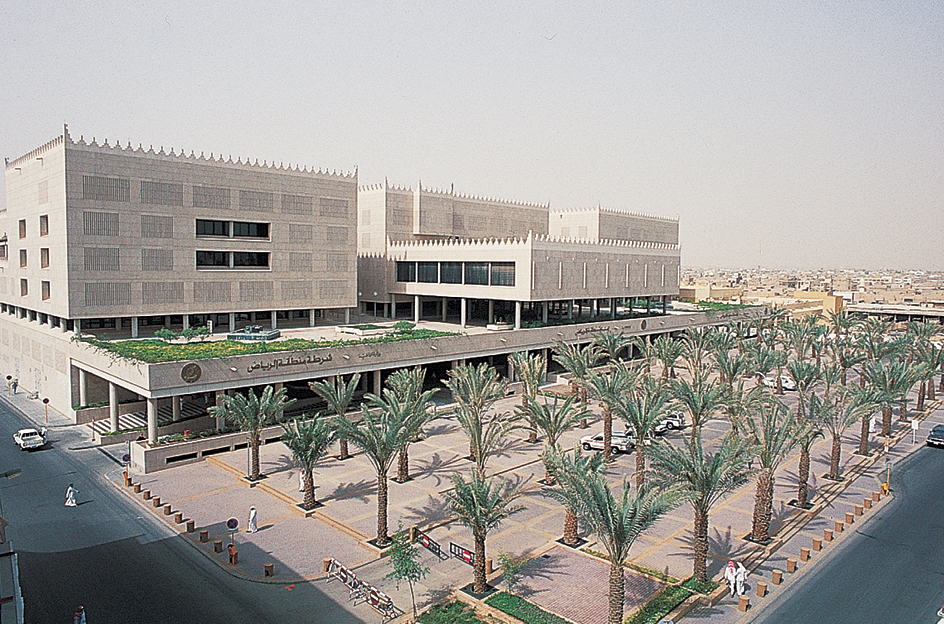
Armed forces.
Saudi Arabia has an army, a navy, an air force, and air defense forces. All military service is voluntary. A National Guard handles internal security. The United States has provided Saudi Arabia with military training and most of its modern military equipment.
People
Most of Saudi Arabia’s people live in cities and towns. Riyadh, Saudi Arabia’s capital and largest city, has about 7 million people. Jiddah, on the Red Sea, is the second largest city with about 3 3/4 million people.
Ancestry.
The people of Saudi Arabia are racially and ethnically mixed, though a majority of the population trace their origin to Arab tribes. In the past, many African blacks were brought to Arabia as slaves. They later gained their freedom and married Arabs and people of other ethnic backgrounds. In the western region are descendants of African, Indonesian, and Indian Muslims who originally came as pilgrims. People whose ancestors were Turkish administrators and soldiers in Ottoman times also live in the west. Saudis in the east include descendants of people from Iran, as well as descendants of African slaves.
Many of the kingdom’s inhabitants are foreigners who have moved to Saudi Arabia because of the large number of jobs created by the country’s oil wealth. These foreign workers come mainly from Asia and nearby Arab countries.
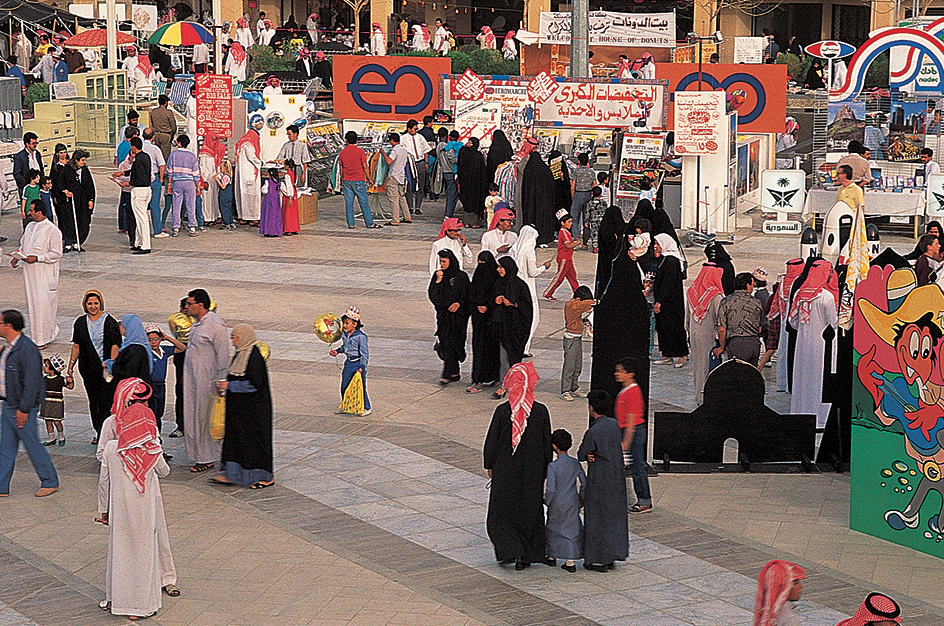
Language.
Almost all the people of Saudi Arabia use Arabic, which is the official language of the country. English is taught in intermediate and secondary schools and is widely used among foreigners and within the business community.
Way of life
The development of the oil industry has caused many advances in the Saudi way of life, especially in the cities. The country has used much of its oil income to build schools, transportation systems, and communication networks. The government also has taken steps to improve housing and to extend electric service and other modern conveniences to Saudi Arabia’s remote rural areas.
Family ties are strong among most Saudis. Although a Saudi father is considered the head of his family, his wife has much authority in running the household.
Outside the home, Saudi women have traditionally had little freedom or opportunity for personal advancement. As the country has developed economically, however, it has undergone a number of social changes as well. Some of these changes have affected the way of life of Saudi women, especially in the cities. Before 1960, few women received any formal education, and almost no women held jobs outside the home. Since then, the government has improved educational and employment opportunities for women. Increasing numbers of women work in such fields as teaching, medicine, and social work. They also hold jobs in journalism, administration, and research, and in shops and banks that provide goods and services only to other women. But the activities of Saudi women are still restricted in various ways. For instance, women are not allowed to travel without permission of a male guardian.
City life.
Modern homes and high-rise buildings stand in Saudi cities and have replaced nearly all the mud houses of earlier times. People in the cities work in a variety of occupations and industries. Many have jobs in government service and in industry.
Socializing with friends and family remains the most popular form of entertainment. Public movie theaters were banned in the 1980’s, but a hotel in Riyadh was allowed to show cartoons to women and children in 2005. Radio, television, and home videos are popular. Many Saudi men enjoy traditional sports, such as camel racing and horse racing. They also play basketball, soccer, and volleyball.
Rural life.
Most rural Saudis follow a simple way of life. Many of Saudi Arabia’s rural people live in farm villages or oasis settlements. A smaller number are either nomads (traveling herders) or seminomads. The nomads, called Bedouins, move through the deserts with their herds of camels, goats, and sheep in search of water and pastureland. The seminomads follow a nomadic way of life part of the year but spend several months in rural settlements. The vast majority of nomads and seminomads have now become settled farmers or have moved to urban areas. There, the men have found a variety of work, including jobs as taxi drivers, oil laborers, National Guardsmen, and police officers. 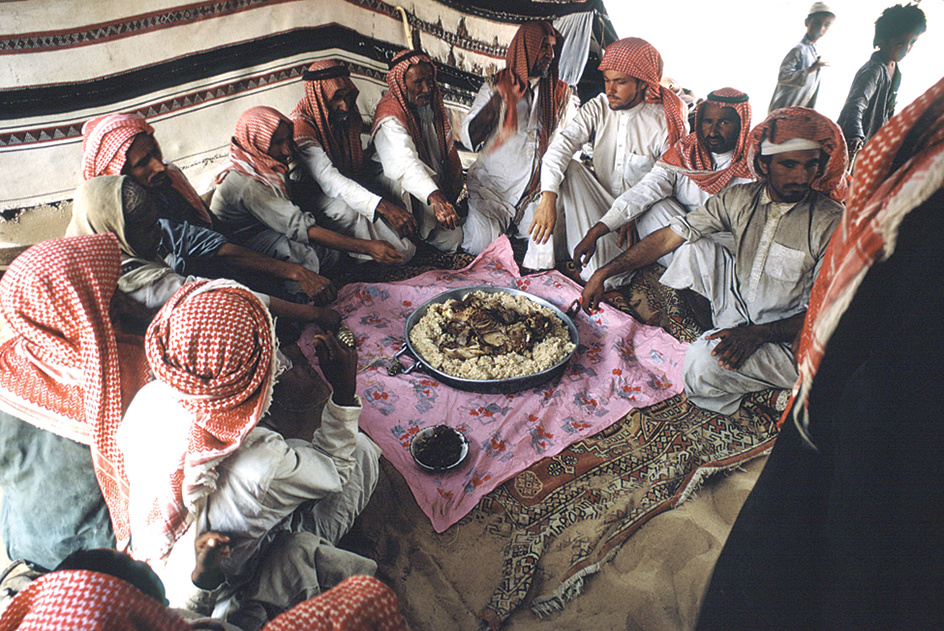
Arabic contemporary Bedouin music
A typical Saudi farm village consists of a cluster of houses made of stones or sun-dried mud. The Bedouins live in large tents made of goat hair. The village marketplace serves as a social center. There, farmers and Bedouins gather to buy and sell goods and to chat with friends.
Clothing.
Most Saudis, in both urban and rural areas, wear traditional Arab clothes. Men wear an ankle-length cotton or wool garment called a thawb (also spelled thobe), which may be covered by a jacket or cloak. A head covering called a ghutra provides protection against the sun and wind. It consists of a piece of cloth held in place by a rope band called an iqal (also spelled igal). Outside, women cover their hair with a scarf and their face with a veil, and they wear a floor-length robe called an abaya.
Food and drink.
Dairy products, dates, lamb, bread, and rice are the chief foods in a traditional Saudi diet. Supermarkets in the major towns and cities of Saudi Arabia offer a wide variety of imported and locally produced foods, including fresh fruits and vegetables. Tea and coffee are the most popular beverages. The laws of Islam forbid the eating of pork and the drinking of alcoholic beverages.
Religion.
More than 90 percent of all Saudis belong to the Sunni branch of Islam. Members of the Shi`ah, another branch, live mainly in the Eastern Province. The only non-Muslims in Saudi Arabia are foreigners. 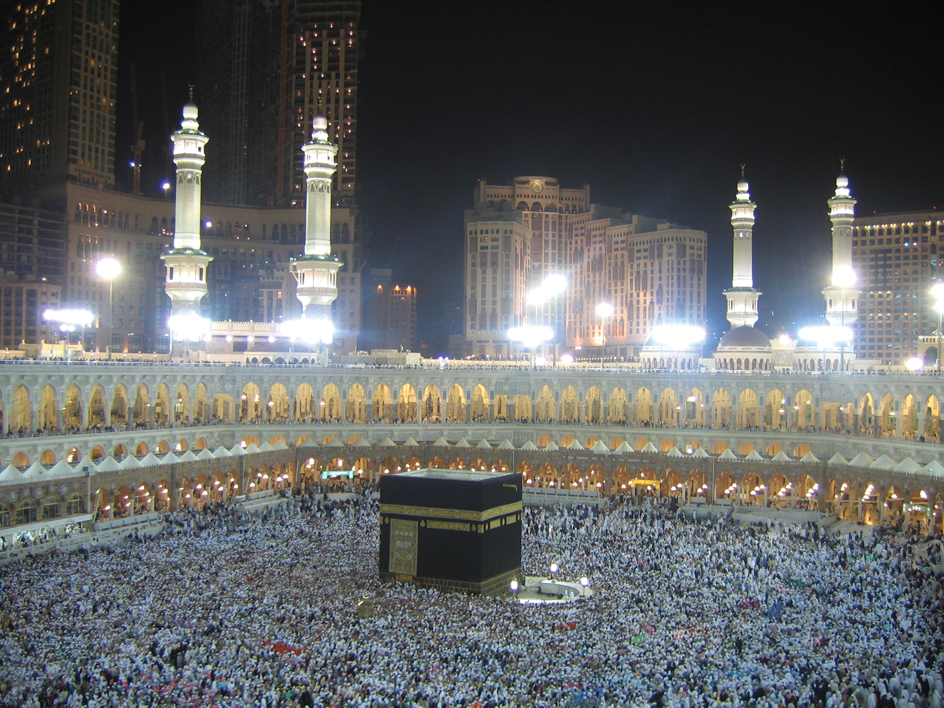
Islam influences family relationships, education, and many other aspects of life in Saudi Arabia. Most Saudis follow a conservative interpretation of Sunni Islam called Wahhābism. The Wahhābis believe that Muslims are obliged not only to understand the laws of God and live accordingly but also to encourage their neighbors in fulfilling God’s laws. Therefore, Islamic rules of behavior are followed with a high degree of conformity across Saudi society. A religious police force, whose patrolmen are called the mutawwiin, helps enforce the rules of behavior. For example, the mutawwiin ensure that shops close for prayer times and that people on the streets are properly dressed.
Since the mid-1970’s, Saudi religious charities have helped fund the construction of mosques and madrasahs (Islamic religious schools) throughout the world. Many of these institutions teach Wahhābism.
Education.
Almost all of the people of Saudi Arabia 15 years of age or older can read and write.
The government provides free schooling for Saudi citizens at all levels of education. School attendance is not required by law. The first public schools were established in 1951, for boys only. Public education for girls began in 1960. Today, more than 80 percent of children of primary school age attend school, and boys and girls are enrolled in almost equal numbers. In public schools, boys and girls study a similar curriculum.
Saudi Arabia has many universities and colleges. King Saud University (at one time known as Riyadh University) was the kingdom’s first university. It opened in 1957.
The land
Saudi Arabia consists largely of dry, barren land that slopes downward from west to east. The country has no permanent rivers or other bodies of water. During rainstorms, dry valleys called wadis fill with water, but the water quickly evaporates or soaks into the ground.
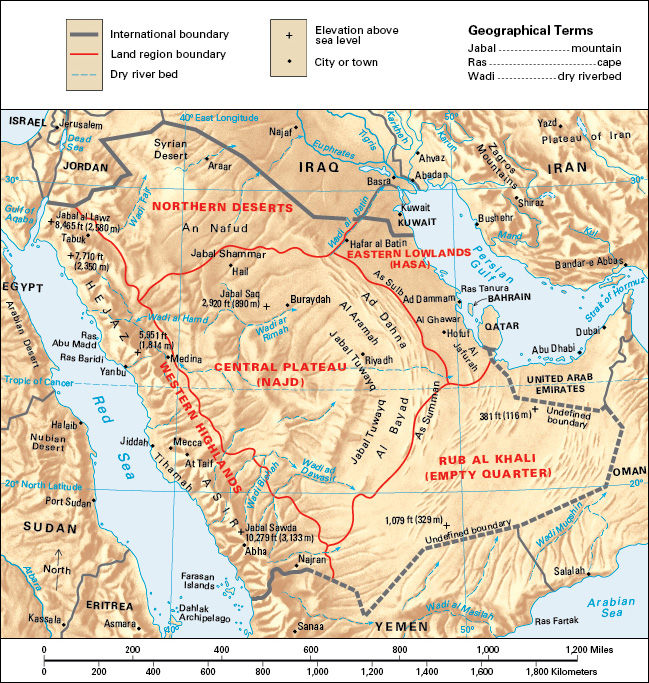
Saudi Arabia can be divided into five land regions. They are: (1) the Western Highlands, (2) the Central Plateau, (3) the Northern Deserts, (4) the Rub al Khali, and (5) the Eastern Lowlands.
The Western Highlands
border the Red Sea. The northern part of this region is called Hejaz, and the southern part is known as Asir. Along much of the Hejaz coast, low, rocky mountains rise up sharply from the sea. The mountains slope more gently toward the east. In parts of Hejaz and in Asir, a narrow coastal plain called the Tihamah separates the sea from a ridge of rugged mountain peaks. The highest peaks in Asir rise more than 9,000 feet (2,700 meters) above sea level. Asir is a fertile area and small farm villages are scattered throughout much of this region. Farmers grow a variety of crops in the Tihamah and in terraced fields on the mountainsides.
The Central Plateau.
The mountains of Hejaz and Asir slope eastward toward the Central Plateau, also called Najd. Most of this large region has little vegetation. In parts of the rocky plateau, fertile oases support large farm communities. Nomadic herders bring their animals to feed on patches of grass that grow in the region for a short time after occasional rainfall.
The Northern Deserts
lie north of the Central Plateau. Most of this thinly populated region consists of a vast area of sand dunes called An Nafud. The Syrian Desert, a low-lying plain of rock and gravel, covers the northernmost area.
The Rub al Khali
is a huge sandy desert that covers about 250,000 square miles (647,500 square kilometers) of southern Saudi Arabia. In English, the name of this vast, desolate area is the Empty Quarter. Windswept sand dunes reach heights of nearly 1,000 feet (300 meters) in parts of the Rub al Khali. Other areas are flat. The Rub al Khali is uninhabited, except for a few groups of nomadic people who travel through it or use it for grazing their herds in the spring.
The Eastern Lowlands,
also known as Hasa or the Eastern Province, lie along the Persian Gulf. Salt flats extend along parts of the shallow coastline. Sand and gravel cover most of the inland plain, which holds the world’s largest known deposits of petroleum. The oil industry has led to the development of Dhahran and other cities and towns in the lowlands. The region also has several fertile oases fed by plentiful natural springs that support large agricultural settlements. 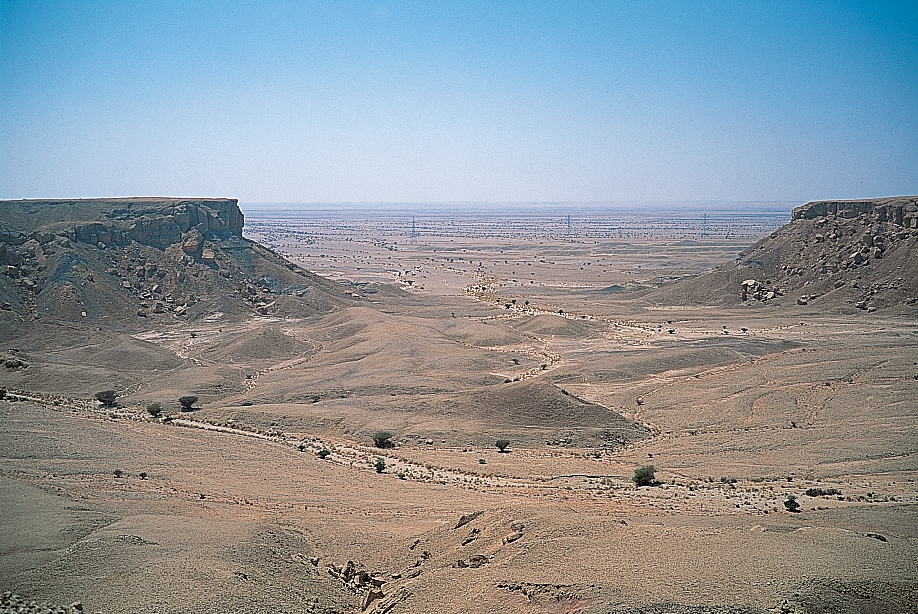
Climate
Most of Saudi Arabia has a hot climate the year around. The coastal regions are hot and humid during the long summers, when the average daytime temperature is over 90 °F (32 °C). Summer temperatures in the Central Plateau and the desert regions may reach 120 °F (49 °C). But these areas have drier air and cool nights. From November to April, temperatures throughout the country are lower than in summer. Winter temperatures in parts of central, northern, and western Saudi Arabia occasionally dip below freezing.
Asir is the only part of Saudi Arabia that receives significant rainfall. Seasonal winds calledmonsoons bring rain to Asir and cause an average annual rainfall in the range of 12 to 20 inches (30 to 51 centimeters). The rest of the country receives less than 4 inches (10 centimeters) annually. Parts of the desert regions of Saudi Arabia may have no rainfall at all for several years in a row. A northwesterly wind called the shamal causes frequent sandstorms, called sumoom, in eastern Saudi Arabia.
Economy
Saudi Arabia has experienced a period of rapid development since the price of oil rose sharply in the mid-1970’s. Recognizing that the oil reserves are limited, however, government planners have encouraged the development of agriculture and new industries to keep the Saudi economy strong when the oil resources eventually run out.
Natural resources.
Saudi Arabia has the largest reserves of petroleum in the world. The country’s huge oil fields contain about a sixth of the world’s oil reserves. The richest oil fields are in the Eastern Province and in the Persian Gulf. Small deposits of gold are in the west. Saudi Arabia has deposits of copper, iron, lead, silver, and zinc, but they are largely undeveloped. The country also has clay, gypsum, and limestone.
Saudi Arabia has no permanent rivers or bodies of fresh water, and, as a result, obtaining adequate water has been a constant challenge. The main source of water for Saudi agriculture is a huge reservoir that runs underground from the eastern highlands of Turkey. Desalination plants in the Red Sea and the Persian Gulf provide much of the water for Saudi cities and towns. Desalination plants remove salt from seawater.
The oil industry.
Saudi Arabia is a leading producer of both natural gas and oil, and is the world’s largest exporter of crude oil. The country plays a leading role in the Organization of the Petroleum Exporting Countries (OPEC) (see Organization of the Petroleum Exporting Countries (OPEC)). The oil industry is owned by the state and largely operated as the Saudi Arabian Oil Company (Saudi Aramco). 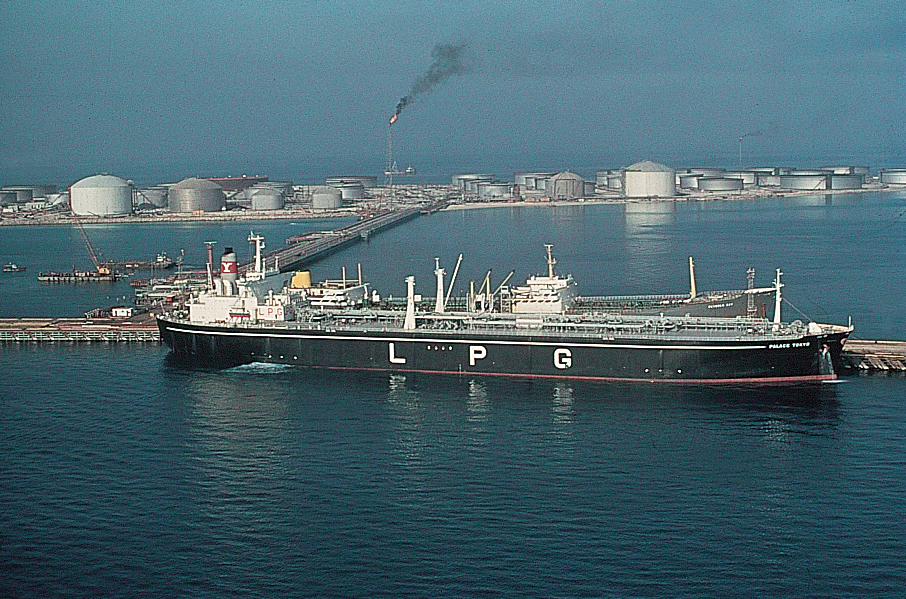
Agriculture.
Cattle, goats, and sheep are important sources of dairy products and meat. Chickens and eggs are also produced. Only about 1 percent of Saudi Arabia’s land is used to grow crops. Cultivated areas include Asir in the southwest and scattered oases.
Farmers grow a number of crops, including citrus fruits, dates, olives, potatoes, sorghum, tomatoes, watermelons, and wheat. The introduction of modern irrigation techniques during the mid-1900’s has enabled Saudi farmers to produce higher yields and a greater variety of crops. Even so, Saudi farmers cannot yet produce all the food the country needs. As a result, Saudi Arabia still imports a large percentage of its food. Saudi Arabia has only a small fishing industry. Shrimp caught in the Persian Gulf are the only important seafood product.
Other industries.
A number of major industries in Saudi Arabia, like the petroleum industry, are owned by the state. The large Saudi Basic Industries Corporation (SABIC), which is mostly government owned, operates plants that produce a variety of products, including chemicals, fertilizers, and steel.
Millions of people visit Saudi Arabia each year, and they provide a substantial amount of income. Many of them are pilgrims to Mecca.
Transportation and communication.
A good road system connects various parts of Saudi Arabia. A railway connects Riyadh with the Persian Gulf port of Ad Dammam, and a high-speed railway links Mecca and Medina with the Red Sea port of Jiddah. The government owns and operates Saudi Arabian Airlines. Dhahran, Jiddah, and Riyadh have international airports. Ras Tanura, a Persian Gulf port, handles most of Saudi Arabia’s oil exports. The country’s other major ports include Ad Dammam and the Red Sea ports of Jiddah and Yanbu.
All of Saudi Arabia’s radio and television stations are owned and operated by the government. However, millions of Saudis have satellite dishes and can watch foreign TV stations. The country’s newspapers are privately owned. Most are published in Arabic, and a few are published in English.
International trade.
Saudi Arabia exports more than it imports. Petroleum and petroleum products account for the majority of Saudi Arabia’s exports. Exports other than oil include chemicals and plastics. Leading imports are chemicals, food products, iron and steel, machinery, and motor vehicles. The country’s chief trading partners include China, Germany, India, Japan, South Korea, the United Arab Emirates, and the United States.
History
For thousands of years, people in what is now Saudi Arabia have adapted their way of life to conditions of the land. In oasis settlements, where water was available, the ancient inhabitants carried out small-scale agriculture. Herders raised sheep and goats in nearby desert pasture. With the domestication of the camel, an animal that can survive for days without water, people began to transport goods across the desert and to live as nomads.
In coastal areas, trade centers linked the peninsula to East Africa, India, Mesopotamia, and the Mediterranean. From the mid-400’s B.C. to about A.D. 100, the Nabataean kingdom in the north controlled the trade routes in what are now northwestern Saudi Arabia and Jordan. The kingdom of Saba (called Sheba in the Bible) developed in the southern part of the peninsula, in what is now Yemen. About 700 B.C., the kingdom became a trade center for frankincense, myrrh, and spices.
The rise of Islam.
Muhammad, the prophet of Islam, was born in Mecca about A.D. 570. At that time, most of the people of the Arabian Peninsula worshiped many gods. But especially in the northwest, near the present-day Medina, there were also some Christians and many Jews, who worshiped only one God. Muhammad, too, taught that there was only one God and that there would be a day of judgment when people would have to answer for their misdeeds.
As Muhammad attracted followers, he made enemies of the wealthy classes in Mecca. In 622, he and a few followers left Mecca for Medina. His emigration from Mecca to Medina is known as the Hijra, also spelled Hijrah or Hegirah. In Medina, he became the spiritual and political head of a new Muslim community. He returned with an army and captured Mecca in 630. By the time Muhammad died in 632, much of the Arabian Peninsula was under Muslim rule.
After Muhammad’s death, his successors, called caliphs, conquered the rest of Arabia and an area stretching from Egypt to Iran. Eventually, the empire extended as far east as India and across North Africa as far west as Spain. In 661, the caliph Mu`āwiya ibn Abī Sufyān established his capital in Damascus, in present-day Syria. In 762, the capital moved to Baghdad, in what is now Iraq. Though the political center of the Muslim empire had shifted out of Arabia, Medina remained a hub of intellectual life. One of the four schools of Islamic law had developed in Medina. Hejaz, which holds the sites of the Muslim pilgrimage, remained the spiritual center of Islam.
Beginning in the late 900’s, Hejaz fell under the rule of Muslim dynasties in Egypt. In the early 1500’s, the Ottoman Empire gained control over Hejaz and parts of Asir in western Arabia. The Hejaz cities developed an international, cosmopolitan character because of their attraction as a pilgrimage center. Najd, by contrast, was isolated by deserts and a mountain range that separated it from Hejaz. Najdi villages remained under local control, and huge, nomadic tribal confederations maintained their independence and their own system of government. Hasa in the east became a center for Shī`ites during the 800’s. It came under the control of the Ottomans from the 1500’s to the mid-1600’s and again in the 1800’s.
The Saud dynasty.
About 1500, the Saud dynasty (family of rulers) established control over a small area around the town of Dariyah, (also spelled Diriyah), near what is now Riyadh. The dynasty remained relatively unimportant until the mid-1700’s. In the mid-1700’s, a leader named Muhammad ibn Saud, formed an alliance with a religious reformer named Muhammad ibn Abd al-Wahhāb.
Ibn Abd al-Wahhāb believed that Muslims should follow a strict interpretation of the Islamic law found in the Qur’ān and Sunnah. He condemned the custom of visiting the tombs of saints and other practices as departures from true Islam as originally taught by Muhammad. He also thought that people should be educated in religion so that they could understand what God expects of them. Ibn Abd al-Wahhāb and Muhammad ibn Saud turned Dariyah into a center of religious learning. Teachers in Dariyah trained missionaries, who were sent out to convert the Bedouins and the villagers. The missionaries were followed by the army of the Saudi rulers.
By 1806, the Saudis and their religious movement controlled Najd, Mecca, Medina, and most of the east coast of the peninsula. They had begun to make raids into Iraq and Syria. Acting on behalf of the Ottoman government, a son of the governor of Egypt drove the Saudi forces back to Dariyah. He captured the town in 1818. The reigning Saudi ruler was taken to Istanbul, the capital of the Ottoman Empire, where he was executed. Dariyah was destroyed. By forming loose alliances with tribal leaders, the Saud family regained control of most of Najd within a few years and moved their capital to Riyadh. In 1891, a member of the Al Rashid family of northern Najd captured Riyadh. The leaders of the Saud family fled to Kuwait.
The founding of Saudi Arabia.
In 1902, Abd al-Azīz ibn Saud, one of the young Saudis who had fled to Kuwait, led a military raid and captured Riyadh. During the next 25 years, Ibn Saud, as he became known, fought to regain the territory that his ancestors had controlled. His forces captured Hasa in 1913. They gained control of most of Asir in 1920. They defeated the Al Rashid in northern Najd in 1921. In 1924 and 1925, Ibn Saud took over Hejaz, and in 1932, he proclaimed the lands under his control as the Kingdom of Saudi Arabia.
Ibn Saud’s success was due largely to his revival of the Wahhābi movement. The forces used in his conquests were called the Ikhwān (Brothers). They were former Bedouins who had converted to Wahhābi beliefs and settled on the land in agricultural and religious communities known as hujar (also spelled hijar). In the conquered territories and in the hujar, the Ikhwān tried to enforce strict Islamic observances. Ibn Saud eventually broke the power of the Ikhwān, but their zealousness as Wahhābi Muslims has left its mark on the character of Saudi society to this day.
The new kingdom
formed by Ibn Saud was isolated and undeveloped. Most of the people were farmers living in poverty or nomads who lived much as their ancestors had lived for hundreds of years before them.
The development of Saudi Arabia’s oil industry began in 1933. That year, Ibn Saud’s government granted Standard Oil of California, an American oil company, the right to explore for and produce petroleum in Saudi Arabia. Other oil firms later joined the California company. These companies became the Arabian American Oil Company (Aramco) in 1944. A major petroleum deposit was discovered in 1938, but large-scale production did not begin until after World War II ended in 1945.
After the war, the oil industry developed rapidly and brought wealth to Saudi Arabia. Aramco paid the Saudi government a share of its profits in return for the right to produce and sell oil. Ibn Saud began economic and social programs in Saudi Arabia. The Saudi government and Aramco built many roads, schools and hospitals.
In 1953, Ibn Saud organized a Council of Ministers as a step toward modernizing the government. Later that year, Ibn Saud died, and his oldest son, Saud, became king of Saudi Arabia. Saud’s brother Faisal became became prime minister and next in line to the throne. Saud continued the development programs begun by his father. But Saud’s government spent money unwisely. As a result, the country faced serious economic problems by the late 1950’s. In 1958, Saud gave Faisal control over the government. Faisal restored economic stability. But he resigned as prime minister in 1960 because of disagreements with Saud. Saud again took control of the government.
In 1962, a civil war in Yemen (Sanaa), now part of Yemen, caused a crisis between Saudi Arabia and Egypt. Yemeni military leaders had overthrown their government and set up a republic. Egypt supported these rebels, while Saudi Arabia backed Yemeni royalists who fought to restore the former government. The conflict threatened to become a war between Saudi Arabia and Egypt. Tension continued until 1967, when Egypt withdrew its forces from Yemen (Sanaa).
In the early 1960’s, Saud’s health weakened, and with it his ability to rule. In 1962, Faisal again became prime minister. In 1964, a council of royal family members and religious leaders forced Saud to give up the throne. They then made Faisal king.
Continued progress.
Profits from the oil industry financed the construction of hospitals, schools, and apartment buildings. The government improved and expanded the country’s transportation and communication systems. At the same time, Saudi Arabia began to take a more active interest in Arab and world affairs.
Following the start of the Six-Day War between Israel and Egypt, Iraq, Jordan, and Syria in June 1967, Faisal sent troops to Jordan and Syria. However, they were not involved in combat. The Six-Day War left Israel in control of the entire Sinai Peninsula, the Golan Heights of Syria, and the Gaza Strip. Israel also controlled the West Bank—that is, all the territory previously held by Jordan west of the Jordan River. This land included part of Jerusalem, one of Islam’s holiest cities. Faisal took a strong stand against this Israeli occupation.
After another Arab-Israeli war broke out in 1973, Faisal used Saudi Arabia’s oil as an economic weapon against nations supporting Israel. Saudi Arabia and several other Arab oil-producing countries temporarily stopped exporting petroleum to the United States and the Netherlands. They also sharply reduced oil shipments to other countries they classed as “neutral.” The cutback created serious fuel shortages in many countries.
In 1973, the Saudi government took over part-ownership of Aramco’s oil facilities. In 1980, the government completed payment for ownership of Aramco’s oil facilities and assets. The take-over of the company by Saudi Arabia became official when the Saudi Arabian Oil Company (Saudi Aramco) was formed in 1988.
In the mid-1970’s, oil prices jumped sharply, causing a dramatic increase in Saudi Arabia’s wealth. The added income enabled the government to devote huge sums of money to new projects. In 1974, Saudi Arabia and the United States signed an agreement to cooperate in such areas as education, science and technology, agriculture, and industrialization.
In March 1975, King Faisal was assassinated by one of his nephews. Khalid, a half brother of Faisal, succeeded Faisal as king and prime minister. Khalid made his half brother Fahd first deputy prime minister and next in line to the throne. Khalid died in 1982, and Fahd became king and prime minister. 
Khalid and Fahd generally continued Faisal’s policies. Saudi Arabia continued to take an active role in Arab and world affairs. Rapid construction of transportation and communication facilities continued, and industry expanded. But a sharp decline in worldwide oil prices reduced the country’s income. The government began to put more emphasis on developing human resources and less on constructing physical facilities. These policies included steps to increase the training of Saudi people in skills needed for management and technical jobs.
The Persian Gulf War of 1991.
In 1990, Iraqi forces invaded and occupied Kuwait. Saudi leaders feared that Iraq would next try to take over the oil fields in the Eastern Province. A number of nations opposed to the Iraqi occupation joined Saudi Arabia in a military operation to drive Iraq out of Kuwait. The allies included Egypt, Syria, and several other Arab countries, as well as the United States, the United Kingdom, and other Western nations.
In January 1991, the allied operation against Iraq began. The United States provided a majority of the fighting personnel and equipment. Saudi Arabia provided the staging area for the attack, called the Persian Gulf War of 1991. The Saudis contributed military and communications equipment; housing for aircraft, military personnel, and arms; and most of the financial resources. By the end of February, Saudi Arabia and its allies had driven the Iraqis out of Kuwait. Though a military success, the Persian Gulf War of 1991 became controversial in Saudi Arabia. It contributed to a rise in conservative and anti-American sentiment there. The cost of the war also forced the Saudi government to reduce spending on social and economic programs.
Recent developments.
In the mid-1990’s, King Fahd’s health began to decline. His half brother Abdullah, next in line to the throne, became increasingly responsible for running the Saudi government. Fahd died in 2005, and Abdullah became king and prime minister. 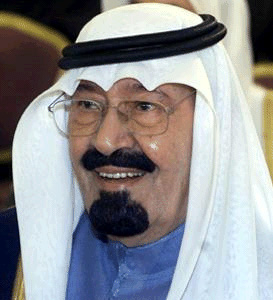
Thousands of U.S. troops remained in Saudi Arabia after the Persian Gulf War of 1991. Those troops enforced a flight ban on Iraqi aircraft over southern Iraq. The presence of U.S. forces in Saudi Arabia contributed to Arab resentment of the United States. The terrorist organization al-Qa`ida, led by the Saudi-born millionaire Osama bin Laden, strongly opposed the U.S. troop presence. Al-Qa`ida is believed to have been responsible for several terrorist attacks against U.S. targets, including the Sept. 11, 2001, attacks against the World Trade Center in New York City and the Pentagon Building near Washington, D.C. In 2003, at the beginning of the Iraq War, a U.S.-led coalition invaded Iraq and overthrew the Iraqi government. Later that year, the United States withdrew nearly all its troops from Saudi Arabia.
In 2005, municipal elections were held throughout Saudi Arabia. Only men were allowed to vote in them. They were the country’s first municipal elections ever, and Saudi Arabia’s first political elections of any kind since 1963. In 2011, King Abdullah announced that women would be allowed to vote and run for office in elections scheduled for 2015.
Abdullah died in January 2015. His half brother Salman then became king and prime minister of Saudi Arabia. In December, women voted and ran for office for the first time in elections. Women won 20 of the country’s 2,100 municipal council seats.
Also in January 2015, rebels in neighboring Yemen forced Yemeni President Abd-Rabbu Mansour Hadi from power. In an effort to help restore Hadi, Saudi warplanes began bombing the rebel forces in March. A Saudi-led coalition of nations continued bombing rebel targets in Yemen into 2022. The coalition faced international criticism because its military actions resulted in many civilian deaths. The warring sides agreed to a truce in April 2022. Peace talks began in April 2023, following the restoration of diplomatic relations between Saudi Arabia and Iran. Iran had been supporting the Yemeni rebels.
In 2018, Jamal Khashoggi, a Saudi journalist working for The Washington Post, a U.S. newspaper, was murdered at the Saudi consulate in Istanbul, Turkey. Khashoggi had written newspaper columns critical of the Saudi regime, including Crown Prince Mohammed bin Salman. The Saudi government later confirmed Khashoggi’s murder, but it remained unclear who was responsible. The government tried 11 suspects in the murder. In December 2019, 5 of them were sentenced to death and 3 others were sentenced to prison. Those sentenced to death were later pardoned. In March 2020, a Turkish court charged 20 Saudi Arabian nationals in the case. However, the suspects had fled Turkey after the killing, and the Saudi Arabian government rejected calls for their arrest. In July, the trial of the 20 accused began in Turkey. Some foreign analysts claimed that Khashoggi’s death may have been authorized at higher levels of the Saudi government. But the government denied any such authorization. In 2022, the trial was transferred from Turkey to Saudi Arabia.
In September 2019, missiles and drones from an unknown source attacked Saudi oil facilities at Khurais and at Abqaiq, near Dhahran. The attacks caused fires and damage at the facilities, temporarily reducing Saudi oil production. Rebels in Yemen claimed responsibility for the attacks, but Saudi Arabia and other nations blamed Iran. Iran denied responsibility.
In September 2022, Crown Prince Mohammed bin Salman became prime minister. The post is typically held by the Saudi king.
